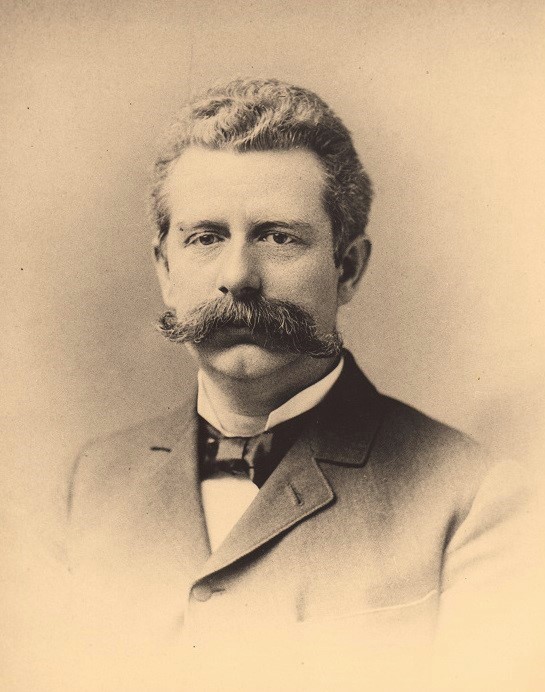
Edward Winter

An article on Showalter by G.H. Diggle which was published in the August 1985 Newsflash and on pages 24-25 of the second volume of Chess Characters (Geneva, 1987):
‘Fifty years ago died Jackson Whipps Showalter (1860-1935), several times American Champion in the 1890s and perhaps the most striking character ever to have held that title. He was a late starter, still a local Rook player at 23, and indeed the last man one would suppose would play chess at all. The son of a wealthy Kentucky farmer, he led a rustic life, believed in “fresh air and beef” and was a connoisseur of cigars. His portrait shows a handsome, stalwart, genial man with an enormous moustache curling round his face; he was just under six feet and weighed 13 “stone when in condition” – in his youth he was a crack baseball player and in England “would have been a cricketer with a good strain of football thrown in”.
The year 1887 found him in New York, where with increased opportunity his chess improved so rapidly that in six months he was the equal of “Delmar, Hanham and that ilk”. Two years later his entry was accepted for the great double-round Sixth American Congress of 1889. Here he made his name at once, coming equal 9th out of 20 with a score of 18, including individual wins against Blackburne, Burn, Taubenhaus, Delmar and Pollock. In 1890 he won the US Chess Association Championship Tourney at St Louis. He lost the title (hereafter decided by match play) in 1892, being challenged and heavily defeated by Lipschutz (+1 –7 =7), but came back and deposed his victor in 1895 (+7 –4 =3). In 1896 he disposed of two challengers, beating Barry (+7 –2 =4) and Kemény (+7 –4 =4). But in 1897 a far more dangerous menace appeared, and he went down to the great Pillsbury after putting up a tremendous fight (+8 –10 =3); the score at one point was 8 all. This, the Companion justly remarks, was his best match performance, and the Brooklyn club presented him with “a hundred dollar bicycle in honour of his splendid fight”. In a return match with Pillsbury in 1898 he again lost (+3 –7 =2) and was never Champion again. Showalter also played other matches, in 1893 losing to Lasker (+2 –6 =2), in 1899 beating Janowsky (+4 –1 =2) but losing to him (+2 –7 =4) later in the year, and in 1909 losing to Marshall (+2 –7 =3). [Addition on 18 October 2024: The record of the contests against Janowsky is complex and will be discussed in a future C.N. item.]
All his chess was played in the States till 1896, when he began to compete abroad – Nuremberg 1896 (equal 16th out of 19), Vienna 1898 (14th out of 19), Cologne 1898 (equal 6th out of 16), London 1899 (8th out of 15), Munich 1900 (equal 7th out of 16) and Paris 1900 (equal 7th out of 17). His last tournament was his best – Cambridge Springs 1904 (5th out of 16). Though an uneven tournament player, the only masters against whom he failed to score at least one win were Lasker, Schlechter and Mason. He did better against English masters and his own countrymen than against the “Continentals”, his tournament aggregate being +3 –3 =1 against Blackburne, +3 –1 =0 against Bird, +4 –3 =0 against Burn, and +1 –2 =7 against Pillsbury, but it was +0 –4 =1 against Lasker, +0 –3 =7 against Schlechter, +1 –6 =2 against Janowsky, +3 –5 =2 against Chigorin, +1 –5 =1 against Maróczy and +2 –3 =1 against Steinitz.
Cable matches seemed to be his forte. Playing second board (with Pillsbury 1st) for the USA v Great Britain from 1896 to 1901 inclusive, he beat Burn (twice), Locock and Atkins, drawing against F.J. Lee and losing to James Mason. The amount of “weed” consumed on both sides of the Atlantic in the two Burn matches was not recorded – but Showalter lit one cigar from another and Burn started off “with a row of seven pipes all loaded”. Showalter married in 1887 “a beautiful girl” ten years his junior. The marriage was a happy one, as she not only liked chess, but took to it under her husband’s tuition to such a degree that in 1894 she actually played a match with the great Lasker, receiving the odds of the queen’s knight, and won +5 –2 =0.’
As mentioned in C.N. 5857, Charles Dealtry Locock published his reminiscences on pages 7-12 of the January 1933 BCM, and the final passage is reproduced here:
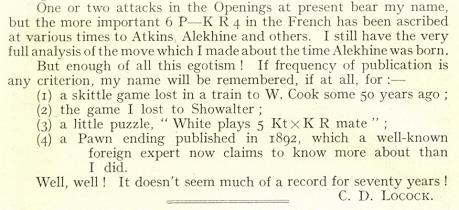
As shown in the American Chess Magazine, 1898-99 and in Vabanque Dawid Janowsky 1868-1927 by D. Ackermann (Ludwigshafen, 2005), the results of the contests between Janowsky and Showalter were as follows:
18 November 1898 - 12 January 1899: Janowsky +7, Showalter +2, Drawn 4;
15-20 March 1899: Janowsky +2, Showalter +4, Drawn 0;
29 March-7 April 1899: Janowsky +2, Showalter +4, Drawn 1.

From page 302 of the American Chess Magazine, January 1899 (acknowledgement: the Cleveland Public Library).
Kevin Marchese (Canal Winchester, OH, USA) informs us that he is writing a book on Jackson Whipps Showalter, with the assistance of some of the master’s relatives, and that the work will show that Showalter was born on 5 February 1859 (and not 5 February 1860, as previously believed). His exact place of birth is still being investigated.

This sketch (from life) of Showalter by Mrs G.A. Anderson was published on page 67 of the 1922 issue of Chess Pie. It was also reproduced to accompany an article on Showalter by W.H. Watts on pages 44-45 of the Chess Budget, 11 November 1925.
(5706)
In C.N. 5706 a correspondent reported that Showalter was born on 5 February 1859 and not, as commonly stated in reference books, on 5 February 1860. See too C.N. 6972.
Is further documentary evidence available?
(11074)
From the unpublished 1994 edition of Jeremy Gaige’s Chess Personalia:

An additional reference is pages 44-45 of the Chess Budget, 11 November 1925:
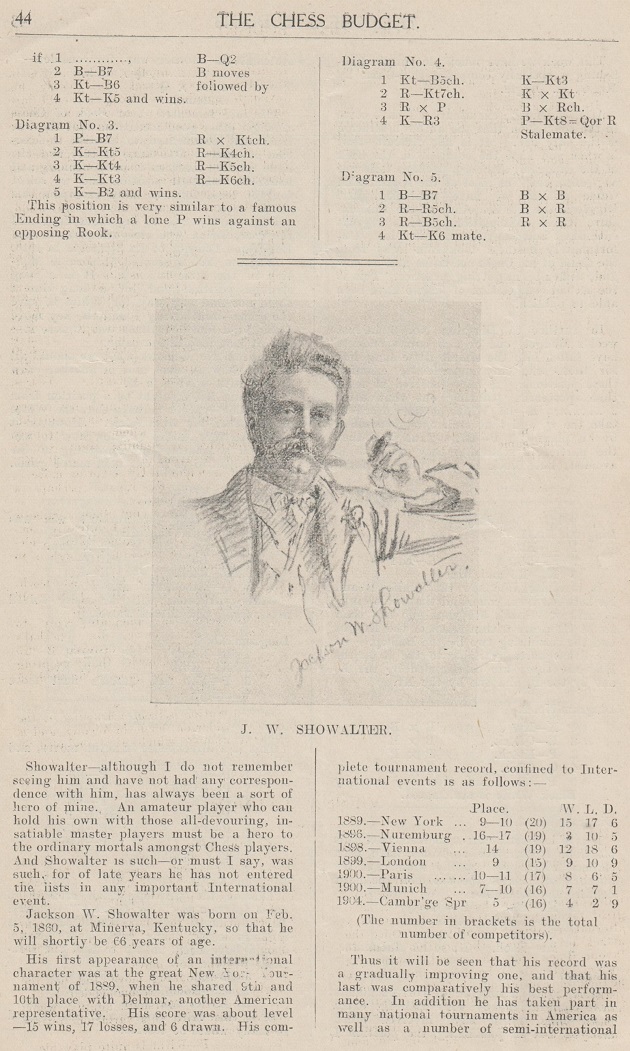

C.N. 5706 mentioned a statement that Showalter was born on 5 February 1859, and not 5 February 1860, but the appeal in C.N. 11074 for documentary evidence has yet to be answered.
(11719)
C.N.s 5706, 6972, 11074 and 11719 have discussed, inconclusively, J.W. Showalter’s year of birth. From C.N. 5706 (posted on 9 August 2008):
Kevin Marchese (Canal Winchester, OH, USA) informs us that he is writing a book on Jackson Whipps Showalter, with the assistance of some of the master’s relatives, and that the work will show that Showalter was born on 5 February 1859 (and not 5 February 1860, as previously believed). His exact place of birth still requires investigation.
Nothing much more has been made available to C.N., and it is unclear why the English-language Wikipedia article on Showalter and his World Chess Hall of Fame page state unequivocally and without evidence that he was born in 1859. The entry for Showalter in Jeremy Gaige’s 1994 edition of Chess Personalia is reproduced in C.N. 11719. It states that Showalter was born in Minerva, KY on 5 February 1860.
We have now received the following from John Townsend (Wokingham, England):
‘When Jackson Whipps Showalter died on 5 February 1935 in Scott County, Kentucky, a death certificate was issued, an image of which can be viewed on familysearch.org, whose help is acknowledged with thanks. The date of birth on the certificate, in Mason County, Kentucky, was entered as 5 February 1860. He was a farmer, aged 75, and the cause of death was “Carcinoma of Rectum”. His parents were named as Freeman Showalter (born in Pennsylvania) and Margaret R. Whipps (born in Mason County, Kentucky).
In the United States Census of 1900, in Scott County, Kentucky, he is named as J.W. Showalter. Misidentification is impossible because he is described as a “chess player”, born in Kentucky. The 1900 census specified the month and year of birth: February 1860. His approximate age was stated to be 40. His father, B.F. Showalter, was still alive then, aged 89, born in Pennsylvania, and his father was born in Virginia.
These two primary sources from official documents are consistent.
Other censuses give only the approximate age, and allowance should be made for a year or two either side. Showalter has not been found in the 1860 or 1890 censuses. The following table summarizes the age information traced in the various census returns:
1860: Not found
1870: Age 11
1880: Age21
1890: Not found
1900: Born February 1860, age 40
1910: Age 50
1920: Age 60
1930: Age 71.Regarding Kentucky births, information on ancestry.com, whose help is also acknowledged with thanks, suggests that two sons of the chessplayer’s father and mother were born at Bracken, Kentucky. Neither can be identified as Jackson Whipps Showalter – at least, not at this stage. One is “A.J. Showalter”, while the other child is not named, both having been born alive. The dates of these appear on ancestry.com as February 1859 and February 1858 respectively. However, the years do not seem to be visible as part of the birth-dates, familysearch.org giving February 1860 and February 1859 for the same two births. On ancestry.com I found lists of the years and counties covered, including those for Bracken:
Bracken: 1854-59, 1861, 1875-76, etc.
Mason: 1855-59, 1861, 1874, etc.This suggests that there is a gap in the record indexes for 1860, the most likely year of birth of Jackson Whipps Showalter (according to the two primary sources discussed above).
A secondary source, the Chess Budget, 11 November 1925, pages 44-45, was quoted in C.N. 11719 as supporting the birth-date of 5 February 1860.
In conclusion, there is strong evidence that Jackson Whipps Showalter was born on 5 February 1860. If there is a case for 5 February 1859, let us see the details of the evidence.’
(12046)
The reference in C.N. 11719 above in Jeremy Gaige’s Chess Personalia is to a particularly rich article ‘Judd and Showalter’ (biographies and games) by W.H.K. Pollock on pages 237-248 of the June 1892 BCM. See also C.N. 4450 below.
Addition on 21 October 2024:
At the English Chess Forum a thread begun by John Townsend is discussing, in particular, Showalter’s date of birth and the members of his family.

In the game between Burn and Showalter in the 1898 cable match between Great Britain and the United States the above position arose after White’s 29th move. The US master now played 29...b3 30 Bxb3 axb2 31 Rdl Nxe4+ 32 fxe4 Bxe4 33 Nc3 Bg6 34 Nb1 Rc8 35 Ke3 Rc1 36 Na3 Rxd1 37 Bxd1 b1(Q) 38 Nxb1 Bxb1 39 a4 Kd6 40 a5 Kc5 41 Be2 Bc2 42 h4 Ba4 43 a6 Kb6 44 g4 Bd7 45 Ke4 Bc8 and Black won after move 58.
Page 578 of the March 1898 American Chess Magazine declared regarding 29...b3: ‘A remarkable continuation, and one in which Showalter says he counted 11 moves through a sacrifice and recovery’. On page 157 of the April 1898 BCM James Mason called the ending ‘remarkable and instructive.’
(2167)
See also Long Calculation.
Below, in our translation from the French is a description of London, 1899 on pages 210-213 of La Stratégie, 15 July 1899, the writer being identified only as ‘André de M.’:
...
‘Showalter has the head and hair of a Goliath. He has a way of putting his elbows on his knees and heavily rocking his powerful body, when he reflects, as if a combination demanded the expenditure of muscular force in equal measure to intellectual force.’
Showalter is standing fifth from the left in this photograph taken at the tournament:
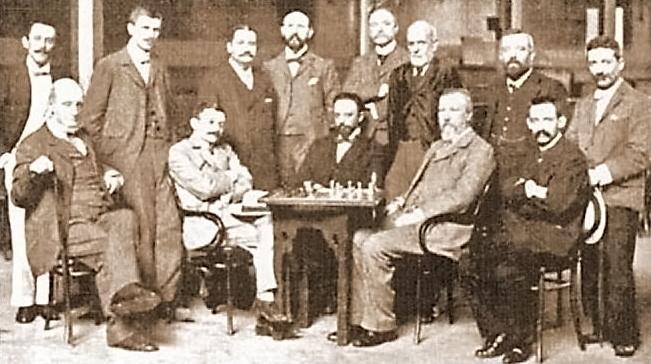
For a full key, see C.N.s 5528 and 5868, as well as London, 1899 Pen-portraits.
A curiosity from the game I. Spero v J.W. Showalter, Louisville, 1922:
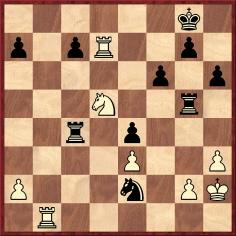
In this position a draw was agreed. White thus overlooked mate in two with 34 Nxf6+, a possibility which both players saw two minutes after the game was over. Source: American Chess Bulletin, December 1922, page 191.
(Kingpin, 2000)
We are grateful to HarpWeek LLC for permission to reproduce a group photograph which appeared in Harper’s Weekly at the time of the New York, 1893 tournament:
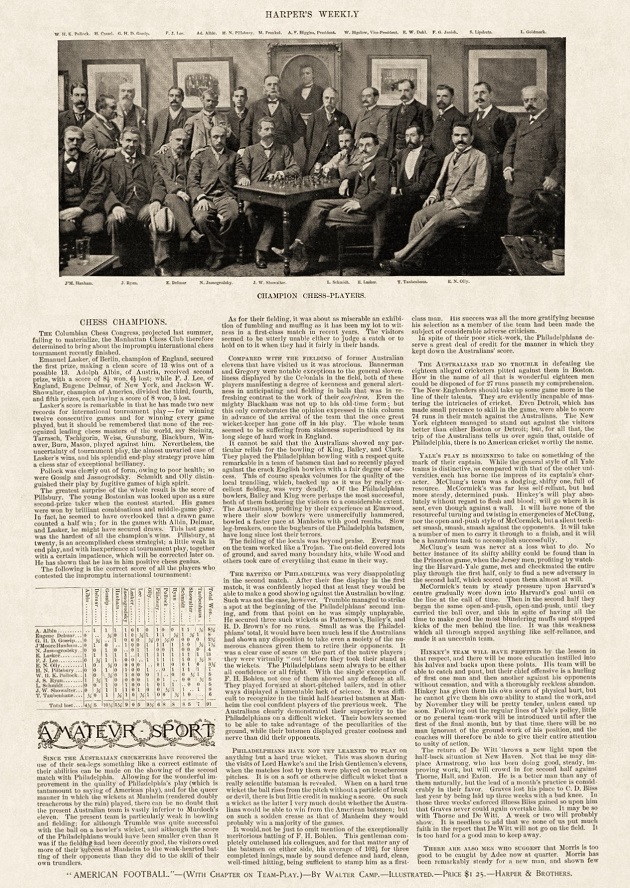
From left to right in the back row: W.H.K. Pollock, H. Cassel, G.H.D. Gossip, F.J. Lee, A. Albin, H.N. Pillsbury, M. Frankel, A.F. Higgins, W.Bigelow, E.W. Dahl, F.G. Janish, S. Lipschütz and L. Goldmark.
Front row: J.M. Hanham, J. Ryan, E. Delmar, N. Jasnogrodsky, J.W. Showalter, L. Schmidt, Em. Lasker, J. Taubenhaus and E.N. Olly.
(3240)
Regarding Gossip’s win against Showalter, Steinitz commented on page 388 of the [New York, 1889] tournament book:
‘One of the finest specimens of sacrificing play on record. Mr Gossip deserves the highest praise for the ingenuity and depth of combination which he displayed in this game.’
(3241)
Jerry Spinrad (Nashville, TN, USA) informs us that he is researching the baseball career of Jackson Showalter and is seeking, in particular, substantiation of the widely-published claim that Showalter invented the curve ball. Information about any early occurrences of that claim will be appreciated.
We note that it was mentioned, sourcelessly, by A. Soltis on page 30 of the April 1980 Chess Life. On the general subject of Showalter and baseball we can give a couple of quotes from pages 242-245 of the June 1892 BCM:
‘... he received a first-class school and college education – which included baseball.’
‘His tendency is the national game of baseball – in England he would have been a cricketer with a good strain of football thrown in. He travelled with the Georgetown baseball team, of which he was the only amateur, in a successful Southern tour some years ago, encountering all the crack teams from the Ohio River to the Gulf, New Orleans included. ... He is a baseball crank.’
(4449)
W.D. Rubinstein (Aberystwyth, Wales) writes:
‘In baseball, the pitcher attempts to get the batter to strike out by throwing a variety of tricky pitches. One of the oldest is the “curveball”, in which the pitcher puts a spin on the baseball such that it appears to curve away from the batter and then back towards him as it travels from the pitcher’s throwing arm to home plate.
The curveball has been a part of baseball since the 1860s or early 1870s and is generally regarded as having been invented around 1867 by William “Candy” Cummings, although there are several other claimants. The first recorded use of the term “curveball” is in the New York Herald on 7 July 1874 according to page 118 of The Dickson Baseball Dictionary by Paul Dickson (New York, 1989).
It seems clear that Jackson Showalter, who was born in 1860, could not have invented the curveball.’
[Regarding Showalter’s year of birth, see the series of C.N. items above.]
(4456)
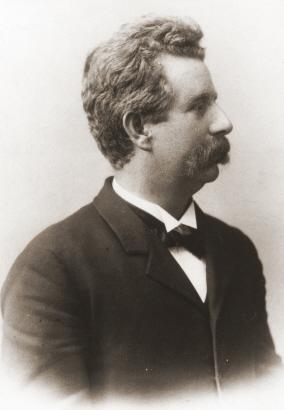
Jackson Whipps Showalter
We now note the following reference in Showalter’s obituary on page 63 of the March 1935 Chess Review:
‘Mr Showalter was famous as a baseball player and was an ardent fan up until the latter part of his life, when bad health kept him at home. He was the first man in Kentucky to pitch a curve ball and one of the seven men who discovered the curve.’
(5700)
Several C.N. items have discussed Jackson Whipps Showalter’s alleged connection with baseball, and in C.N. 5706 Kevin Marchese reported that he was writing a book which would demonstrate that the master’s date of birth was 5 February 1859 (and not 5 February 1860, as commonly believed).
Larry Crawford (Milford, CT, USA) takes up both matters:
‘It appears that Mr Marchese is correct that Showalter was born in 1859. A photograph of his plaque in the Georgetown cemetery reads “1859-1935”. Another webpage says that Showalter was born on 5 February 1859 in Minvera, Bracken Co, KY, the information being taken from the “Kentucky Birth Records 1852-1910”. Furthermore, it is stated that the death records covering the period 1852-1953 gave 1860, which suggests that they may be the source of the error.
As regards claims that Showalter invented the curve ball in baseball, William Arthur “Candy” Cummings is widely accepted by baseball experts as the inventor. His Baseball Hall of Fame plaque lists 1867 as the year of the invention, but Cummings maintained that he thought of the idea as early as 1863 and practiced his delivery for years, which put him ahead of other pitchers of the era. His description below is from a reprint of his article in the September 1908 issue of Baseball Magazine (“How I Pitched the First Curve Ball”) on page 33 of The Neyer/James Guide to Pitchers by R. Neyer and B. James (New York, 2004):
“In 1867 I, with the [Brooklyn] Excelsior club, went to Boston, where we played the Lowells, the Tri-Mountains, and Harvard clubs. During these games I kept trying to make the ball curve. It was during the Harvard game that I became fully convinced that I had succeeded in doing what all these years I had been striving to do. The batters were missing a lot of balls; I began to watch the flight of the ball through the air, and I distinctly saw it curve.”
In a letter published on page 6 of the New York Times on 21 July 1900 James Gordon Spencer stated that he had played with Cummings for a while in the 1860s and that Cummings was pitching a curve at that time. The New York Clipper of 25 June 1870 (page 90) described a game which Cummings pitched against the Cincinnati Red Stockings:
“... the crowd was on the tip-toe of expectation to see whether George could hit the Star pitcher’s horizontally curved line balls ...”
This information supports Professor Rubinstein’s conclusion in C.N. 4456 that Jackson Whipps Showalter (born in 1859) was too young to have invented the curve ball.
He did, though, have a great liking for the sport. When he arrived late for the start of his 1892 match with Lipschütz, some of the spectators joked that he had decided to stay over in Baltimore to watch a baseball game with Boston. On eventually arriving, Showalter told a reporter that he had merely been delayed on his journey, but he added, “Yes, I am still a great admirer of baseball”. (Source: New York Sun, 19 April 1892, page 4.)’
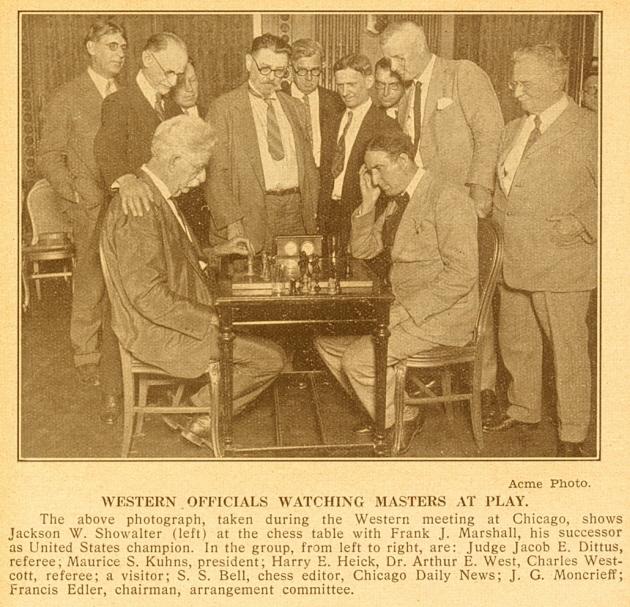
Source: American Chess Bulletin, September-October 1926, page 110
(6972)
See Chess and Baseball.
Page 243 of the June 1892 BCM had the following position:

Jackson Whipps Showalter v Professor J.E. Logan (White to play)
W.H.K. Pollock commented:
‘And here we can save a separate chapter on “Showalter’s Chess Finessing, or High Cunning”, by giving a diagram of a game-ending which does seem to illustrate the peculiar feature called finesse – like a trap, good play, if the prey snaring himself, the trapper loseth neither bait nor tackle. This was the outcome of an Evans, played by correspondence, between Mr S. and a strong amateur of Louisville.
Now White (as the moves will shew) would like Black to play ...Nc4. Therefore he does not play Qf5 at once, but makes a move to prevent ...Nc4, in other words puts it into his opponent’s head to play ...Nc4. The game proceeded 18 Qg4 h5 19 Qf5 Nc4 20 Rxc4 Qxc4 21 Nd5 Qc5 22 Qe6+ Kf8 23 Bxf6 Re8. White announced mate in seven (24 Ne7, etc.).’
The full game-score was given in C.N. 2694 (see page 199 of A Chess Omnibus), from page 382 of La Stratégie, 15 December 1890.
(4450)
See too Chess Cunning, Gamesmanship and Skulduggery and Chess Jottings.
From page 95 of the October 1904 American Chess Bulletin
concerning the Cambridge Springs tournament.

(4563)
Addition on 20 October 2024:
This high-resolution scan has been provided by the Cleveland Public Library:

From item 26 in Napier’s Amenities and Background of Chess-Play (New York, 1934):
‘I remember seeing Showalter in a match game with Pillsbury brood 45 minutes over a fourth move. It was a Ruy López. Afterwards there came the explanation. “The cigar was good; and I thought that long looking might uncover some better move and sequel than those used.”’
(4679)
See also The Chess Wit and Wisdom of W.E. Napier and Long Calculation.
Stephen Davies (Kallista, Australia) reports that pen-portraits of the participants in New York, 1889 were published on page 8 of the New York Times, 16 June 1889, under the heading ‘The Chessboard Kings’, with the subtitle ‘Ways and looks of 20 great players’. The extracts transcribed below (which often go awry with the players’ ages) focus on physical descriptions. ... On Showalter:
The distinguishing traits of Showalter are a tremendously big pair of blonde mustaches and a frank, open countenance. He is tall and dignified in his bearing, and gentlemanly in his behavior. Like many other players he is fond of a good smoke, and likes to have a general good time after his work is over ...
(5710)
Two questions regarding Jackson Whipps Showalter are raised by Kevin Marchese:
1) Is anything known about a meeting between Showalter and Zukertort? Our correspondent quotes the following uncorroborated statement on page 225 of Vlastimil Fiala’s book on Cologne, 1898 (Olomouc, 1997):
‘J.W. Showalter began playing about 1881, being beaten by Zukertort in a simultaneous at Cincinnati about that time.’
2) Is it possible to trace all of Showalter’s games at Cincinnati, 1888 (a tournament which he won by a margin of 3½ points)? At present, Mr Marchese has only Showalter’s victory over Moehle and his draw against Judd.
(5749)
Eduardo Bauzá Mercére (New York, NY, USA) notes that a third game played by Showalter at Cincinnati, 1888 (against J.M. Tomlinson) was given on pages 105-106 of the Columbia Chess Chronicle, 22 September 1888.
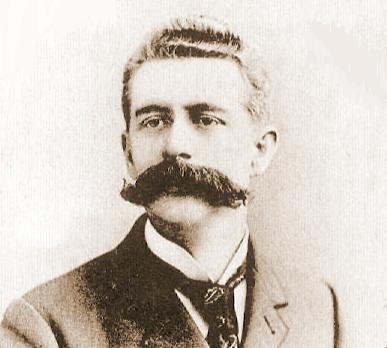
Jackson Whipps Showalter
(frontispiece, BCM, June 1892)
As regards a possible over-the-board meeting between Showalter and Zukertort, Jerry Spinrad reports that the New Orleans Times-Democrat chess column of 20 April 1884 referred to a blindfold simultaneous display in Cincinnati in which Zukertort defeated Treichler, V. Abraham, Showalter and Euphrat, lost to Ettlinger and drew with Dr Keeney. As noted by Harrie Grondijs (Rijswijk, the Netherlands), the account of the display on page 115 of the Brooklyn Chess Chronicle, 15 May 1884 had the spelling ‘Thowalter’ (and stated that Zukertort defeated Dr Keeney). Moreover, page 150 of Mr Grondijs’ book Steinitz with Zukertort (Rijswijk, 2006) quoted the report in the Cincinnati Commercial Gazette of 12 April 1884, which referred to ‘Showalter’.
It remains to be ascertained why, as quoted in C.N. 5749, V. Fiala’s book on Cologne, 1898 stated, ‘J.W. Showalter began playing about 1881 [emphasis added], being beaten by Zukertort in a simultaneous at Cincinnati about that time’.
(5773)
Eduardo Bauzá Mercére sends the third game in the Judd v Showalter match, as published on page 5 of the New York Sun, 13 December 1891, and asks whether the score is correct. In particular, do other sources explain Black’s resignation or mention 38...Qxd6 and 40...Rd3 as possibilities?
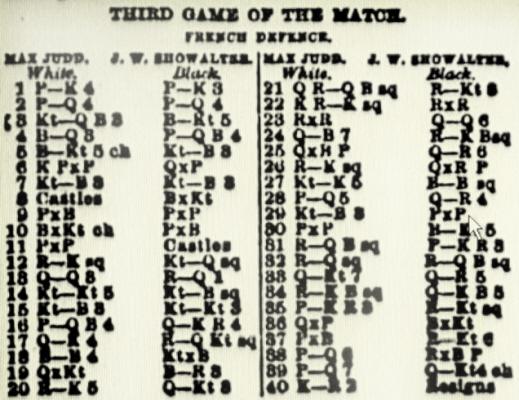
Max Judd – Jackson Whipps Showalter
Third match-game, St Louis, 10 December 1891
French Defence
1 e4 e6 2 d4 d5 3 Nc3 Bb4 4 Bd3 c5 5 Bb5+ Nc6 6 exd5 Qxd5 7 Nf3 Nf6 8 O-O Bxc3 9 bxc3 cxd4 10 Bxc6+ bxc6 11 cxd4 O-O 12 Re1 Nd7 13 Qd3 Rd8 14 Ng5 Nf8 15 Nf3 Ng6 16 c4 Qh5 17 Qe4 Rb8 18 Bf4 Nxf4 19 Qxf4 Ba6 20 Re5 Qg6 21 Rc1 Rb1 22 Ree1 Rxc1 23 Rxc1 Qd3 24 Qc7 Rf8 25 Qxc6 Qa3 26 Re1 Qxa2 27 Ne5 Bc8 28 d5 Qa5 29 Nf3 exd5 30 cxd5 Bg4 31 Rc1 h6 32 Rd1 Rc8 33 Qb7 Qa4 34 Rf1 Qf4 35 h3 Rb8 36 Qxa7 Bxf3 37 gxf3 Rb3 38 d6 Rxf3 39 d7 Qg5+ 40 Kh2 Resigns.
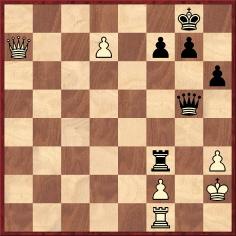
(6713)
From Larry Crawford (Milford, CT, USA):
‘G.H. Mackenzie was considered the US champion “by acclaim”, as was Morphy before him. Mackenzie won the second (Cleveland, 1871), third (Chicago, 1874), and fifth (New York, 1880) American Chess Congresses but was too ill to play in the sixth Congress (New York, 1889). S. Lipschütz was the US player who finished highest behind the five foreign masters at New York. On the assumption that Mackenzie had retired owing to poor health, a claim was made to consider Lipschütz the new US champion. In February 1890 Showalter finished ahead of Lipschütz at the third Congress of the US Chess Association, held in St Louis. Soltis and McCormick wrote on page 29 of the second edition of The United States Chess Championship, 1845-1996 (Jefferson, 1997):
“The gentleman farmer from Minerva, Kentucky [Showalter], then [after St Louis] crowned his success in a short match with Lipschütz and it was on the basis of this that he would later say he was US champion.”
The book gave one game played between Showalter and Lipschütz (“Match, Louisville 1890”).
There are hints here and there about an 1890 Showalter-Lipschütz match:
- “About this time he [Showalter] won nine straight games of Lipschütz (including the two games in the St Louis Tourney), at Cincinnati, Georgetown [KY], Lexington and Indianapolis, winning a purse of $50 offered by the Indianapolis Club.” (Frank Leslie’s Popular Monthly, August 1894, page 249).
- “Beaten by Showalter at St Louis and Indianapolis, he [Lipschütz] subsequently defeated him [Showalter] in a match in New York by seven to one and seven draws.” (Frank Leslie’s Popular Monthly, September 1894, page 250).
- “Played at Indianapolis, in an unfinished match between Messrs. J.W. Showalter of Georgetown, Ky and S. Lipschütz of New York, the first and third prize-winners in the recent US Association Tourney.” (BCM, May 1890, page 208). In the BCM one game was given (not the same game as in Soltis and McCormick’s book).
- “Wie verlautet, werden die Herren Showalter und Lipschütz einen Match mit Einsatz von 300$ in Louisville demnächst spielen. (Louisville ist unterdessen durch einen Orkan verwüstet worden. D. Red.)” (Deutsche Schachzeitung, April 1890, page 127). That tornado hit Louisville on March and is unlikely to be relevant to the issue at hand, unless the match was to be held after Lipschütz finished his match with Delmar.
- “Showalter and Lipschütz will go together to Louisville to play a match of seven games for a prize.” (New York Sun, 12 February 1890, page 4).
I found it easier to track Lipschütz’s movements in the New York Sun during early 1890 than those of Showalter. Lipschütz was back in the city in time to play in the State tournament on 22 February. He also had an ongoing match with Eugene Delmar. They played two games in January prior to Lipschütz leaving for St Louis, and they resumed the match on 4 March. They customarily played games on Tuesdays and Saturdays, but with adjournments there were some variations in that schedule. I see games listed on 4, 8, 11, 18 and 29 March and 5, 12, and 19 April, with games seven and eight probably played on 22 and 25 March respectively.
Showalter’s match with Judd began on 19 May 1890. Contemporary newspapers called it a championship match. Here are a few examples:
- “The first game in the match between Max Judd and J.W. Showalter at St Louis for the championship of the United States was played on Monday night.” (New York Sun, 23 May 1890, page 4).
- “Max Judd, of St Louis, and James [sic] Showalter, of Kentucky, opened their series of chess contests at the rooms of the chess club in St Louis last night for the American championship and a purse of $500.” (Brooklyn Daily Eagle, 19 May 1890, page 4).
- “... the chess contest between O. [sic] W. Showalter, the champion of the United States, and Max Judd of St Louis for $250 and the championship ...” (New York Evening Post, 21 May 1890, page 5).
It seems that a Showalter-Lipschütz match would be the basis for Showalter’s original claim to the US championship title, and for such a match to occur after the St Louis tournament and before the Judd match it would need to have taken place between 11 and 22 February 1890 or possibly between 19 April and 19 May 1890.
Further clouding the waters, in a skittle column at the Chess Café Hanon Russell quoted extensively from a letter by Walter Penn Shipley published in Lasker’s Chess Magazine, November 1904 (see pages 13-15):
“After the death of Captain Mackenzie, S. Lipschütz, who had won a number of matches and tournaments, was recognized both in the East and in the West as the American champion. That title was given to him by all the clubs and in the various chess columns published throughout this country and many of those abroad. I never heard the same in any way disputed. In 1891, Showalter challenged Lipschütz for a match for the American championship and a stake of $750 a side.”
When Max Judd was planning the 1904 St Louis American Chess Congress he wanted to call the winner “US champion”. Judd’s position was that while Pillsbury was the strongest player of his day, he never played anyone who held the title of US champion and therefore did not hold the title himself. Pillsbury objected, and both he and Judd appealed to Shipley as an arbiter. Shipley detailed the lineage of the US championship to show that Showalter was, in fact, US champion when Pillsbury defeated him in 1897. The first Showalter v Lipschütz match which Shipley mentioned is the one which Lipschütz won in 1892 (the challenge was issued in 1891, but the match was played in 1892). Shipley was well informed on US chess, knew many top players, and served as the stakeholder for the 1896 Showalter v Kemény match. Was Shipley’s omission of an 1890 Showalter v Lipschütz match an indication that no match took place or that a match began but was not completed?’
(6996)
The chess column on page 3 of the Brooklyn Daily Eagle, 2 July 1914 published, with the winner’s notes, the following practice game, played ‘recently’:
John Taliaferro Beckner – Jackson Whipps Showalter
Occasion?
Sicilian Defence
1 e4 c5 2 Nf3 Nc6 3 d4 cxd4 4 Nxd4 g6 5 c4 Bg7 6 Be3 d6 7 Nc3 Nf6 8 Be2 O-O 9 O-O Ne5 10 h3 Be6 11 b3 Qc8 12 f4 Nc6 13 g4 Bd7 14 g5 Bxh3 15 gxf6 Bxf6 16 Rf2 e5 17 fxe5 Bxe5 18 Nd5 Qd8 19 Nf3 Bg3 20 Ng5 Bxf2+ 21 Kxf2 Be6 22 Qh1 h5 23 Bxh5 Kg7 24 Bg4 Rh8

25 Bxe6 Rxh1 26 Rxh1 Ne5 27 Bxf7 Qh8 28 Rxh8 Rxh8 29 Kg2 b5 30 cxb5 Rb8 31 a4 Nxf7 32 Nxf7 Kxf7 33 Bxa7 Rb7 34 b6 Ke6 35 Nc7+ Kd7 36 a5 Resigns.
(7216)
Olimpiu G. Urcan (Singapore) provides the game below, played in Kentucky, from page 32 of the Brooklyn Daily Eagle, 11 December 1930:
Jackson Whipps Showalter – John Taliaferro Beckner
Georgetown, 1930 (?)
Ruy López
1 e4 e5 2 Nf3 Nc6 3 Bb5 d6 4 c3 Nf6 5 d4 Bd7 6 Qe2 Be7 7 Nbd2 exd4 8 cxd4 O-O 9 O-O Re8 10 Rd1 a6 11 Bc4 Bg4 12 Nf1 d5 13 exd5 Nxd5 14 Qe4 Nf6 15 Qd3 Qd7 16 Ng3 Bd6 17 Bg5 Nh5 18 Ne4 Bf5 19 Re1 Bf4 20 g3 Bxg5 21 Nfxg5 Bg6 22 Rad1 Rad8 23 Qc3 h6 24 Nc5 Rxe1+ 25 Qxe1 Qg4
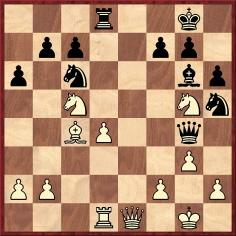
26 Nge6 Re8 27 Be2 Qf5 28 g4 Qf6 29 gxh5 Bf5 30 Nxc7 Qg5+ 31 Kh1 Bh3 32 Qg1 Rxe2 33 Qxg5 hxg5 34 d5 Ne5 35 d6 Rxf2 36 d7 Bxd7 37 Kg1 Rc2 38 Nxd7 Nf3+ 39 Kf1 Nxh2+ 40 Kg1 Nf3+ 41 Kf1 Rxc7 42 White resigns.
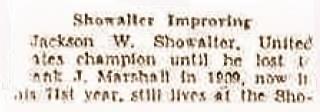

An earlier game between the two players was given in C.N. 7216.
(8186)
Pierre Bourget (Quebec, Canada) notes this photograph on page 230 of the December 1941 Chess Review:
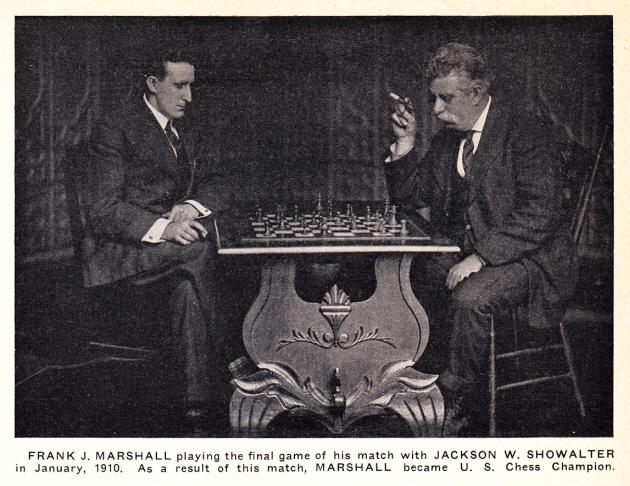
In fact, the match ended on 26 November 1909 (American Chess Bulletin, January 1910, page 7), and the board position bears no relation to the final match-game (in which Marshall was White). The photograph also appeared on page 17 of Marshall’s autobiographical games collection (with a reference to 1909).
From page 9 of the January 1910 Bulletin:
‘With the intention, it is understood, of publishing the entire set of games for the United States championship in book form, Marshall has permitted only a few of the scores of the games to see the light of day. While everyone concedes the right to Marshall to create a possible source of revenue for himself, yet opinion is divided as to whether his course is beneficial to chess in general, and, therefore, to his own interests, or not.’
Marshall did not produce a book on the match.
(7488)
1 e4 e5 2 Bc4 Nf6 3 Nf3 Nc6 4 Ng5 d5 5 exd5 Na5 6 Bb5+ c6 7 dxc6 bxc6 8 Be2 h6 9 Nf3 e4 10 Ne5 Qd4 11 Ng4 Bxg4 12 Bxg4 e3 13 f3 h5 14 Bh3 Qh4+ 15 Ke2 Qf2+ 16 Kd3 Rd8+ 17 Kc3 e2 18 Qg1 Nd5+ 19 Kd3 Ne3+ 20 Kc3 Qxg1 21 Rxg1 Nd1+ 22 Rxd1
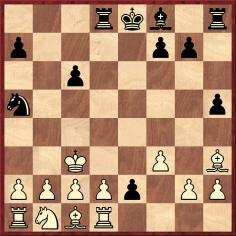
22...exd1(N) mate.
This familiar game is generally said to have been won by J.W. Showalter against A.H. Robbins in Lexington in 1910; see, for example, pages 442-443 of 1000 Best Short Games of Chess by Irving Chernev (New York, 1955).
Eduardo Bauzá Mercére informs us that it was played in the United States Chess Association championship in St Louis in February 1890 and that the score was published on page 5 of the Albany Evening Journal, 21 June 1890:

(8038)
John Nunn (Chertsey, England) submits two queries [the second one is omitted here] about games by Emanuel Lasker:
‘The first relates to Showalter v Lasker, game six of their 1892-93 match:
This position arose after White’s 48th move. The conclusion of the game, as given in both Mega Database and the Weltgeschichte des Schachs book on Lasker (Hamburg, 1958), was 48...Ke6 49 Nc1 h3 50 Nd3 Bg1 51 a6 Kf5 52 Kc3 Bxh2 53 Nf2 Bg1 54 Nxh3 Bb6 0–1.
From the chess point of view, this makes little sense. Although it does not throw away the win, 48...Ke6 has no point whatsoever. Moreover, with these moves 50...Bg1 is a blunder which allows a simple draw by 51 Nf4+, etc. The whole thing makes much more sense if Black had played 48...Ke4 instead, but is there any evidence for this?’
Black’s 48th move was indeed given as ...Ke4, and not ...Ke6, when the game was published, with notes by both players, on pages 152-153 of the 14 July 1893 issue of Lasker’s magazine, the London Chess Fortnightly:
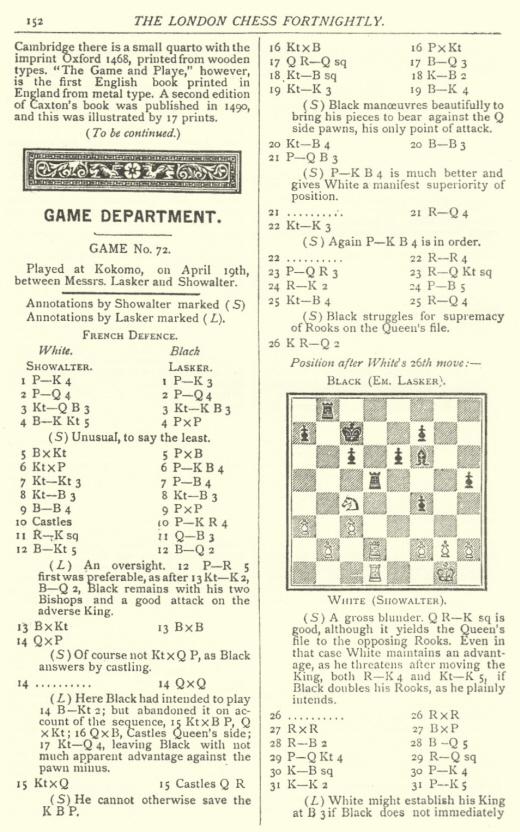

48...Ke4 was also the move specified when the game appeared on pages 298-299 of the September-October 1893 American Chess Monthly. The notes were by Pollock, Lasker and Showalter, the score was from the Pittsburgh Dispatch, and the game was dated 22 April 1893.
(8050)
John Nunn’s assessment of the game subsequently appeared in a book mentioned in C.N. 8660, John Nunn’s Chess Course (London, 2014):

Page 11 (Sports section) of the 25 August 1922 New York Times called Jackson Whipps Showalter the ‘dean of American chess players’.
(10789)
The above C.N. item discusses numerous US players who were awarded the ‘dean’ title.
Addition on 3 November 2024:
Page 146 of the American Chess Magazine, October 1898:
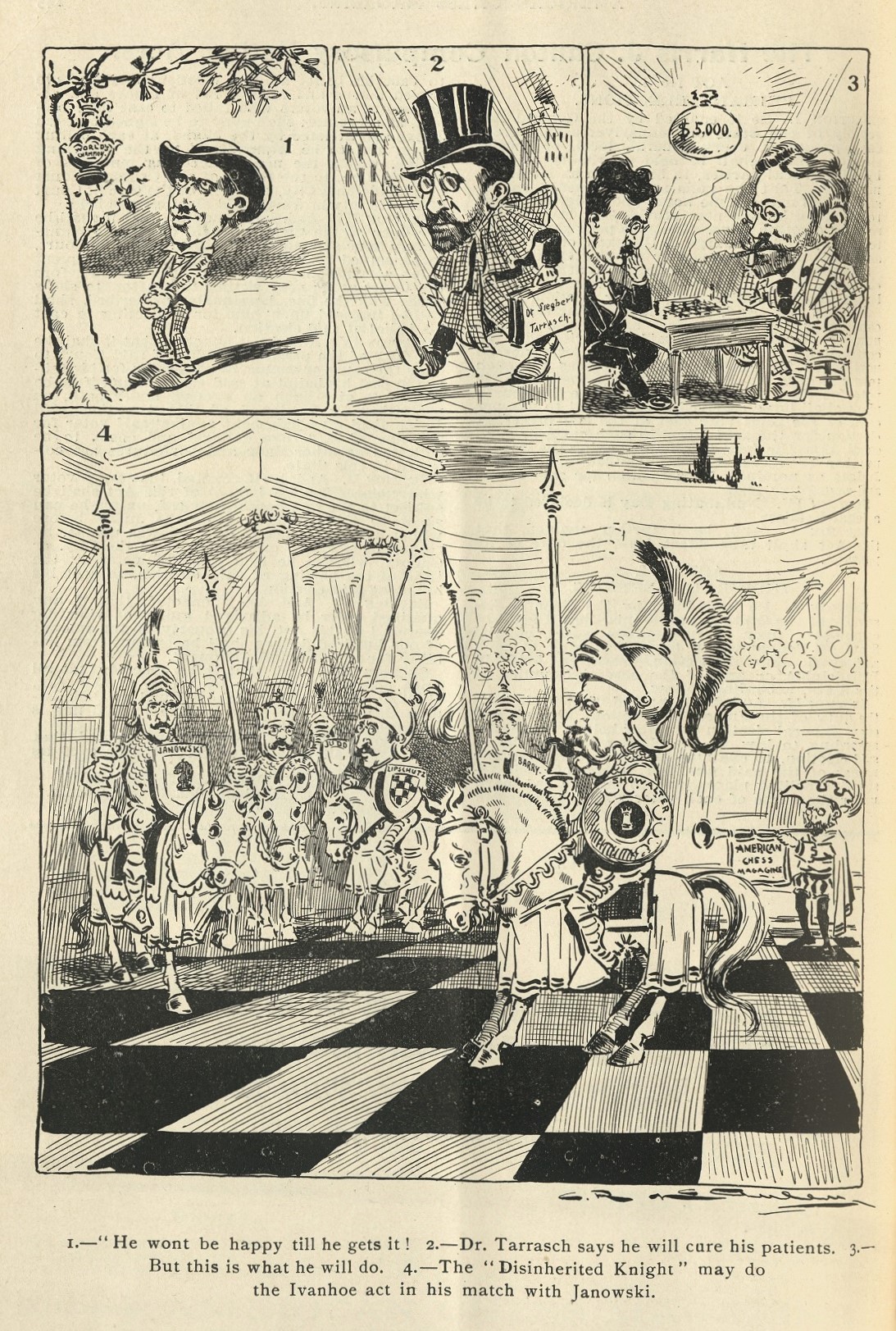
Acknowledgement for the scan: Cleveland Public Library
... The [correspondence game between Alapin and Lange, which began 1 e4 e5 2 Ne2] was shown, from an undated scrapbook of Walter Penn Shipley’s, in C.N. 771 (see page 49 of Chess Explorations) with this concluding remark by Showalter in the New York Recorder:
‘It would be difficult indeed to laud too highly the masterly style in which Herr Alapin conducted his attack in this game, the more especially as applied to the latter half of it. Truly, correspondence chess is the best chess, after all.’
The date of Showalter’s column was 28 January 1894.
(12065)
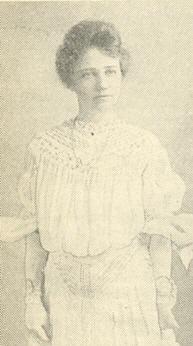
This photograph (see C.N. 4473) is of Mrs Showalter, from page 138 of the December 1904 American Chess Bulletin. The following page described her as ‘without doubt the strongest player of her sex in America’ and reported:
‘Mrs Showalter comes of a prominent Kentucky family, but was born in the state of Missouri in 1872; although her maiden name was Nellie Love Marshall, she claims no family relationship with the new champion bearing the same surname.’
From page 7 of the January 1894 BCM:
‘She is only 22 years of age and was married to him [Jackson Whipps Showalter] at 16. Soon after this event her husband taught her the moves, and then gave her the odds of the queen; but she progressed so rapidly that he cannot now give her the knight, and she has won two games of Mr Lasker at that odds. Not long ago, at Kokomo, Indiana, she played four games on even terms with Mr Jackson, the champion of that State, with the result that she won three and the other was drawn. She is said to be very handsome but, if so, the portrait of her in the New York Recorder does not do her justice ...’
A photograph of their son, Freeman Showalter, who was born in 1895, was published on page 228 of the November 1918 American Chess Bulletin, where he was described by J.W. Showalter as follows: ‘He plays a very good, unpolished and natural game, but without any book training or knowledge acquired from books at all. I think he has considerable talent, in fact, but, of course, undeveloped.’
The obituary of an elder brother of Jackson Whipps Showalter, Judge John William Showalter, was published on page 312 of the January 1899 American Chess Magazine and stated that he was ‘a devoted follower of the game of chess’ and that ‘he taught the moves of chess to Jackson W. Showalter when the future champion was eight years of age.’
(4484)
C.N. 12045 gave, courtesy of the Cleveland Public Library, the above-mentioned obituary of John William Showalter:
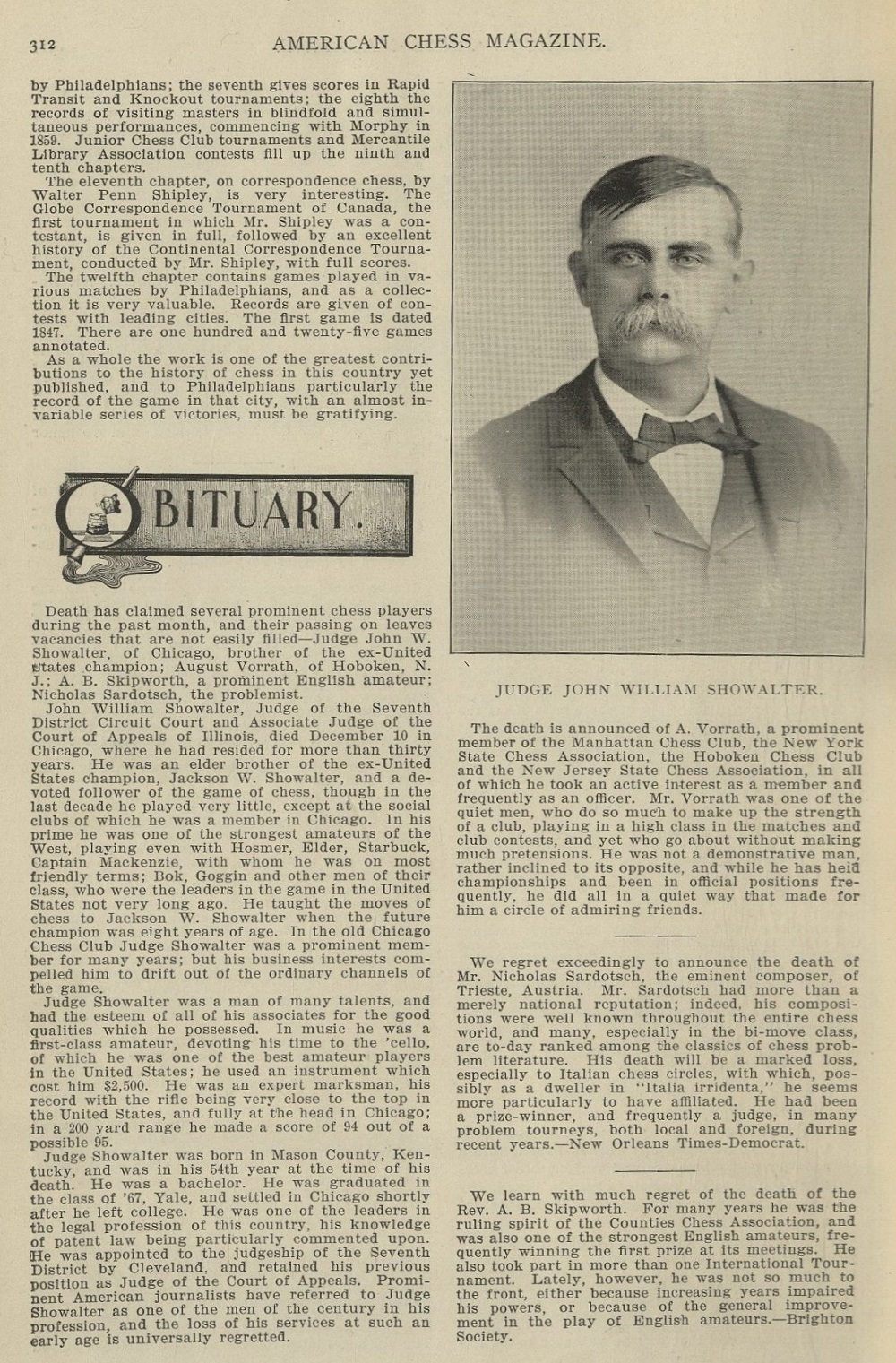
Graham Clayton (South Windsor, NSW, Australia) quotes an item from the chess column in the Queenslander, 7 July 1894, page 16:
‘La Stratégie mentions that Madame Reutlinger-Rosenthal is of the opinion that there is no player living who could give her the odds of a knight, and expresses regret that the distance between France and America precludes her from measuring her chess strength against Mrs Showalter’s.’
Our correspondent requests information about Madame Reutlinger-Rosenthal and asks whether any of her games have survived. Assistance from readers on these matters will be appreciated.
Below is the report referred to by the Queenslander:
‘Le paragraphe que nous avons consacré à Madame Showalter, dans le numéro de février, nous a valu une protestation de Madame Reutlinger-Rosenthal qui estime que personne ne pourrait lui rendre le cavalier. Il est regrettable qu’une si grande distance sépare ces deux dames; après le match Lasker-Steinitz, un match pour la “Dame-Champion des Echecs” serait bien intéressant.’
Source: La Stratégie, 15 April 1894, page 119.
The earlier paragraph in the French magazine (15 February 1894 issue, page 55) read:
‘Madame Showalter est bien la digne compagne du vaillant champion du Kentucky; elle vient de le prouver en gagnant un match à M. E. Lasker, qui lui rendait seulement le cavalier, avec le merveilleux résultat de 5 à 2. Probablement aucune autre Dame ne pourrait obtenir un pareil succès contre le célèbre maître allemand.’
(7218)
The following report, from page 8 of the New York Herald, 12 January 1896, has been submitted by Olimpiu G. Urcan:

Is anything further known about Nellie Showalter v Louis Schmidt?
(7482)
Russell Miller (Vancouver, WA, USA) notes a webpage which provides family details about Nellie Love Marshall Showalter (with a different year of birth from the one shown in C.N. 7482).
The game referred to in our earlier item has been found by Jerry Spinrad, with notes by the loser, in Jackson Whipps Showalter’s column in the New York Recorder of 2 December 1894:
Nellie Love Marshall Showalter – Louis Schmidt
Venue?, 29 November 1894
Scotch Game
1 e4 e5 2 Nf3 Nc6 3 d4 exd4 4 Nxd4 Nf6 5 Nxc6 bxc6 6 Bd3 d5 7 e5 Ng4 8 Bf4 Bc5 9 O-O O-O 10 h3 g5 11 Bg3 Nh6 12 Qh5 Kg7 13 Nd2 Nf5 14 Nf3 h6 15 Bh2 Rb8 16 g4 Nd4 17 Nxd4 Bxd4 18 c3 Bb6 19 e6 Qf6 20 Rae1

20...Qg6 21 Be5+ Kh7 22 e7 Re8 23 Bf6 Ba6

24 Bb1 d4 25 cxd4 Bxf1 26 Bxg5 Qxb1 27 Qxf7+ Kh8 28 Bf6 mate.
(7485)
John Blackstone (Las Vegas, NV, USA) points out an article ‘Chess Playing as a Profession for Women’ by Nellie M. Showalter in the Los Angeles Herald, 6 February 1898, page 24.

(7877)
To the Chess Notes main page.
To the Archives
for other feature articles.
Copyright Edward Winter. All rights reserved.